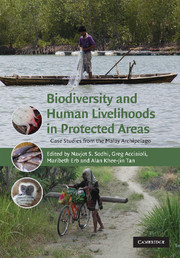Book contents
- Frontmatter
- Contents
- List of contributors
- Acknowledgements
- 1 General introduction
- Part I Conservation needs and priorities
- 2 Introduction to Part I
- 3 Delineating Key Biodiversity Areas as targets for protecting areas
- 4 A Master Plan for Wildlife in Sarawak: preparation, implementation and implications for conservation
- 5 Indonesia's protected areas need more protection: suggestions from island examples
- 6 Birds, local people and protected areas in Sulawesi, Indonesia
- 7 Importance of protected areas for butterfly conservation in a tropical urban landscape
- 8 Biodiversity conservation and indigenous peoples in Indonesia: the Krui people in southern Sumatra as a case study
- 9 Involving resource users in the regulation of access to resources for the protection of ecosystem services provided by protected areas in Indonesia
- 10 Conclusion to Part I
- Part II Conservation with and against people(s)
- Part III Legal and governance frameworks for conservation
- 29 General conclusion
- Index
- References
4 - A Master Plan for Wildlife in Sarawak: preparation, implementation and implications for conservation
from Part I - Conservation needs and priorities
Published online by Cambridge University Press: 12 November 2009
- Frontmatter
- Contents
- List of contributors
- Acknowledgements
- 1 General introduction
- Part I Conservation needs and priorities
- 2 Introduction to Part I
- 3 Delineating Key Biodiversity Areas as targets for protecting areas
- 4 A Master Plan for Wildlife in Sarawak: preparation, implementation and implications for conservation
- 5 Indonesia's protected areas need more protection: suggestions from island examples
- 6 Birds, local people and protected areas in Sulawesi, Indonesia
- 7 Importance of protected areas for butterfly conservation in a tropical urban landscape
- 8 Biodiversity conservation and indigenous peoples in Indonesia: the Krui people in southern Sumatra as a case study
- 9 Involving resource users in the regulation of access to resources for the protection of ecosystem services provided by protected areas in Indonesia
- 10 Conclusion to Part I
- Part II Conservation with and against people(s)
- Part III Legal and governance frameworks for conservation
- 29 General conclusion
- Index
- References
Summary
Introduction
Considerable research has been conducted on the causes of wildlife decline in the Malaysian State of Sarawak on the island of Borneo (e.g. Dewan Undangan Negeri 1985; Caldecott 1988; Bennett 1992; Meredith 1993; Bennett & Dahaban 1995; Dahaban 1996; Bennett et al. 2000). These studies documented the decline of many species, and the importance of wildlife to rural peoples and to the State of Sarawak. In 1994, no comprehensive plan existed to determine how to apply that knowledge to conserving Sarawak's wildlife. Hence, the Government of Sarawak took the unique step of requesting that a ‘Wildlife Master Plan’ for the State be prepared. As far as we know, this is the only comprehensive, officially adopted, cross-sectoral master plan for wildlife anywhere in the tropical world.
We describe how the Master Plan was developed and became official government policy, was implemented, and the long-term effects of the Master Plan on wildlife management and conservation in Sarawak. The chapter concludes with an assessment of successes of the Master Plan to date, and the problems that still need to be addressed. Implementation is still continuing, and data on the full impacts of the process on wildlife populations, and on rural peoples, are still being collected.
State of Sarawak's wildlife populations prior to 1994
Sarawak has amongst the highest number of species of animals for an area of its size anywhere in the world: about 185 species of mammals (Payne et al. 1985), 530 species of birds (MacKinnon & Phillipps 1993), 166 species of snakes, 104 of lizards and 113 of amphibians (Dewan Undangan Negeri 1985).
- Type
- Chapter
- Information
- Biodiversity and Human Livelihoods in Protected AreasCase Studies from the Malay Archipelago, pp. 36 - 52Publisher: Cambridge University PressPrint publication year: 2007
References
- 3
- Cited by



